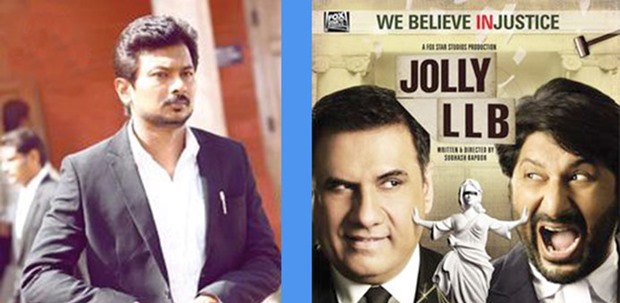Bollywood films like Chak de India and Paan Singh Tomar excelled largely because they did not steer away from their core themes. The first about hockey, and the second about a disillusioned steeplechase runner-turned-rebel engaged me with their neatly crafted scripts and some fine pieces of performance. They did not slip into songs and drown into dances. They did not branch off into silly romances or comic idiocy.
Subhash Kapoor’s Jolly LLB (2013) — also from the Mumbai stable — was as gripping with Arshad Warsi playing a bumbling young lawyer, Boman Irani a seasoned and celebrated advocate and Saurab Shukla a sardonic judge.
For Tamil director I. Ahmed (Endrendrum Punnagai), it could not have been easy to recreate the riveting roles of Warsi, Irani and Shukla through Udhayanidhi Stalin, Prakash Raj and Radharavi, respectively in his latest outing and a remake of Jolly LLB, titled Manithan. And it could not have been any easier to tell the story in the shortest possible time.
To begin with, Ahmed’s movie is 25 minutes longer than Jolly LLB, and he uses this time to incorporate what to me seemed like a needless romantic preamble to the courtroom drama played out by Stalin’s Shakti and Hansika Motwani’ Priya amidst the rural landscape of Pollachi in Tamil Nadu. Ahmed also introduces a new character, a television anchor, portrayed with admirable elan by Aishwarya Rajesh — who captivated us as the impoverished mother of the two boys in Kaaka Muttai. Here in Manithan, she has been given a complete image makeover that she handles with easy conviction. Her several appearances do add a degree of credibility to the plot.
However, Manithan could have certainly cut a lot of flab by doing away with some of the romantic interludes. And, the overflow of emotions — a weakness of Tamil cinema that even a legendary actor like Kamal Hassan cannot fight — considerably weakens the narrative, which otherwise might have been as engrossing as Jolly LLB was.
Shakti travels to Chennai — to the hallowed premises of its High Court, where the novice lawyer hopes to make a mark for himself. His first meeting with the much-feared, the much corrupt, but highly successful advocate, Prakash Raj’s brilliantly acted out Adiseshan, is one of awe. But when the young man in his desperation to earn a living, files a public interest litigation in a hit-and-run road accident case that has been argued by Adiseshan and closed, sparks begin to fly.
Adiseshan had bribed his way through to get his rich, young client — who had, in his drunken stupor, killed five men, women and a child sleeping on the pavement — escape a jail term. And this is where Shakti puts his little finger to shake and stir a judicial system which is often accused of protecting the guilty. Most of us know the story of Jolly LLB, which again was supposedly inspired by a Bollywood actor’s hit-and-run case.
While Prakash Raj with his power-packed dialogue delivery — which enlivens the proceedings in court — outshines Irani in the Hindi version, Stalin is no match for Warsi, whose bumbling, dream-driven guy in a black jacket was such a pleasure to watch. And, Radharavi too pales in comparison to Shukla, whose characterisation of a bored judge — who in the end is urged to do one good deed for the poor — was so nuanced with hitherto unseen mannerisms that I was floored.
Manithan could have made a somewhat better impact had Ahmed kept it trim and to the point, but Tamil cinema is addicted to distractions, and they come in plenty.
* * *
Anurag Kashyap’s Psycho Raman will be part of the 18 titles in the Cannes’ Directors’ Fortnight.
The list was announced in Paris last week by the Fortnight’s Artistic Director, Edouard Waintrop.
Director’s Fortnight is not a part of the Cannes Film Festival, but is a parallel section that runs during the 12 days of the Croisette event. This year, Cannes runs from May 11 to 22.
Nawazuddin Siddiqui — flush with the success of Bajrangi Bhaijan and Manjhi-The Mountain Man — is playing Raman Raghav in Kashyap’s movie.
Psycho Raman is based on a mentally deranged serial killer, Raman Raghav, who, in the 1960s murdered several pavement and hutment-dwellers in what was then Bombay. He was one of the most notorious killers who bludgeoned his victims to death using a hard, blunt object, and those who slept out in the open did so in mortal fear of their lives.
In the 1990s, Calcutta had a serial killer as well, who also used a blunt object to bludgeon to death men and women sleeping on pavements at night. Like Jack the Ripper of the 1880s gaslit London who murdered prostitutes in East End, Calcutta’s “Stoneman” — as he was called — was never found by the police. Despite a massive hunt by London’s Scotland Yard, Jack the Ripper (believed to have been part of the British royalty) remained elusive, and the killings stopped after a point. It was the same case with Stoneman, whose treacherous acts ceased after the few years. But he was never nailed down.
However, Raghav was caught in 1968 and sentenced to a life in prison. He was not given the death penalty, because he was suffering from an incurable mental disorder. He died in 1995 in the Yerwada Central Jail of a kidney disease.
Kashyap’s film is the not the first on the subject. Tamil director Bharathiraja’s Sigappu Rojakkal in 1978 had Kamal Hassan playing Raghav, though the plot here was loosely inspired by the serial murders.
Kashyap’s earlier Gangs of Wasseypur Part One and Two also screened in the Directors’ Fortnight in 2011.
*Gautaman Bhaskaran has been
writing on Indian and world cinema for over three decades, and may be e-mailed
at [email protected]

A promotional image for Manithan, left, which is a remake of Jolly LLB.
